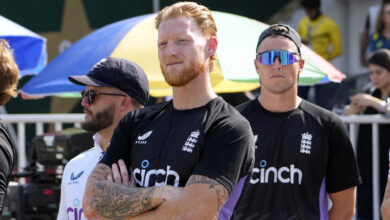How J&K have debunked cliches and broken new grounds in their Ranji journey | Cricket News

The Jammu & Kashmir Ranji Trophy team playing Kerala in the quarterfinals at Pune’s MCA stadium, is slaying clichés, lumped on them unimaginatively all these years. ‘Fast bowlers from Kashmir Valley’, and ‘batsmen from Jammu’ was an unspoken selection quorum. But when beating star-studded Mumbai in their backyard earlier on way to topping the group ahead of knockouts, J&K coach Ajay Sharma turned such geo-labels on their head.
In came, U-23 find, Yawer Hassan Khan, a delightful batsman, instructed to open in a Sam Konstas-like impact promotion. Mumbai fielders stood rooted to their spots, as he timed the ball so fluently off the back foot, driving through covers and flicking off his pads. He comes from Bijbehara in south Kashmir, mined out in a talent hunt, widening the scouting lens that doesn’t equate his region with just workhorse pacers.
Story continues below this ad
But it was Yudhvir Singh, the actual pacer from Jammu-proper, who rocked Mumbai’s core of khadoos batting, claiming Shreyas Iyer, Rohit Sharma and Yashasvi Jaiswal in an 11-wicket match haul. Later in a must-win against Baroda, right arm off-break Sahil Lotra, who hails from Domail in Udhampur, again Jammu, stubbed out their batting defiance, after, “Lotre ko bola gayaa aapkohi wicket lena hai,” recalls manager Hilal Ahmed. He took seven that inning to go with four from the first.
Brigadier Anil Gupta, who helms the three-member BCCI committee running the show, credits coach Sharma with reading pitches pinpoint and shuffling his team combinations and staying resolute through two years of vicious criticism. “Emphasis was on transparency and merit-based selection because we had long suffered from quotas of ‘Jammu player’ and ‘Kashmir player’ and ‘this & that player’. Now all dricts are covered – Doda, Kishtwar, Poonch, Rajouri, Baramulla, Kupwara, Kulgam, Anantnag,” he reels off.
The process was set in motion in 2021, and when failures struck, selections got roasted on social media. “We stuck to our stand, carried out talent hunts, persed with players we knew would come good. Earlier, people wouldn’t allow girls to bat on centre wickets. We said, nothing doing, our girls will get every matching facility,” Brig. Gupta says.
Players emerged from unconventional areas – coal town Kalakote (Abdul Samad), Baramulla (Auqib Nabi), Bhaderwah (Abid Mushtaq), even as top run-getter Shubham Khajuria and newest ‘Mr Wall’ Kanhaiya Wadhwan (71 &84 vs Baroda) continue the Jammu tradition. Auqib was so audacious on his debut that when told he was a night watchman against Punjab, he slammed a century to prove a point. Story continues below this ad
Jammu and Kashmir’s players celebrate after winning a Ranji Trophy cricket match against Mumbai at the Sharad Pawar Cricket Academy BKC in Mumbai. (PTI)
J&K have beaten Mumbai before, besides making knockouts twice – 2001-2 and 2013-14. But self-assurance gleams through when Umar Nazir Mir, their Pulwama pacer, doesn’t celebrate Rohit Sharma’s wicket. Still, when a youngster asked what sort of team the other heavyweight Baroda was, “Mumbai jaisi team hai koi” came the quip.
Past masters, new age
Foundational work was put in two old warhorses, steeped in game-craft, attempting to get J&K to the first semis – coach Sharma and adminration executor, Mithun Manhas. They kept a close eye on Himachal-born Paras Dogra, a 40-year-old playing for Pondicherry. Brig. Gupta recalls, “There was a lot of internal bickering. So the dressing room atmosphere wasn’t great. We needed a captain to pull them all in one direction. We observed Paras for two years, because he’s a good brain, and then brought him in to lead.”
The team overheard smug shrugs of “such a big team like Mumbai won’t fail twice.” It invigorated the underdogs to trigger two memorable collapses.
But quiet, sweaty preparations prepared them for the rigour. “To ensure the hot temperatures and breaking pitches didn’t melt us, we played Chennai’s Buchi Babu tournament, twice and against state teams of Himachal, Chandigarh and Punjab,” Brig. Gupta recalls. Story continues below this ad
Four-day matches were played locally. The natural black soil wickets back home were relaid with red soil of south and west India. “So it wasn’t a handicap for us.” Seven turf wickets and as many central wickets were laid out in Katra, even as JKCA started supplying Kookaburra and SG Test grade balls, used in actual tournaments, were shipped in.
Older players like Shubham Khajuria and Samad, who continued cricket like it were a ‘gentleman’s game’ were convinced they were the backbones of the team and Ajay Sharma and his senior lieutenants would look at the wicket within hours of landing in Pune.
U-23 find Yawer was given confidence to open, and wicketkeeper Kanhaiya Wadhwan freedom to bat cheeky or serious. “They are both quiet and focused on winning. Plus, their fielding, one of India’s best,” manager Ahmed said.
J&K spends considerable time on shuttle sprints, timed at 4.09 seconds. And a pair of Rajasthan stalwarts bowler, P Krishna and fielding coach Dishant Yagnik have propped up acrobatic standards. Most coaches came in, via applications after ads were placed. And despite the absence of star pacer Umran Malik, unheard-of dricts are throwing up names stepping up to the task, with Yudhvir being the latest after returning from Hyderabad. Story continues below this ad
For a young generation that’s only watched Virat Kohli rise to superstardom as a batter (Nasir Lone is even called ‘Nasir Kohli’ due to his mannerisms), the idea of sturdy batting, daddy centuries in domestic, was drilled in, through an airport incident. Manager Ahmed narrates: “We ran into L Balaji at the airport, and he greeted Ajay Sharma as ‘Father of Centuries’, because of his huge runs and average of 68.” Murmurs went around of ‘kya bola?’ Eyebrows went up when numbers were dug up. “Suddenly, 30-40 runs weren’t enough. Everyone wants centuries now.”




